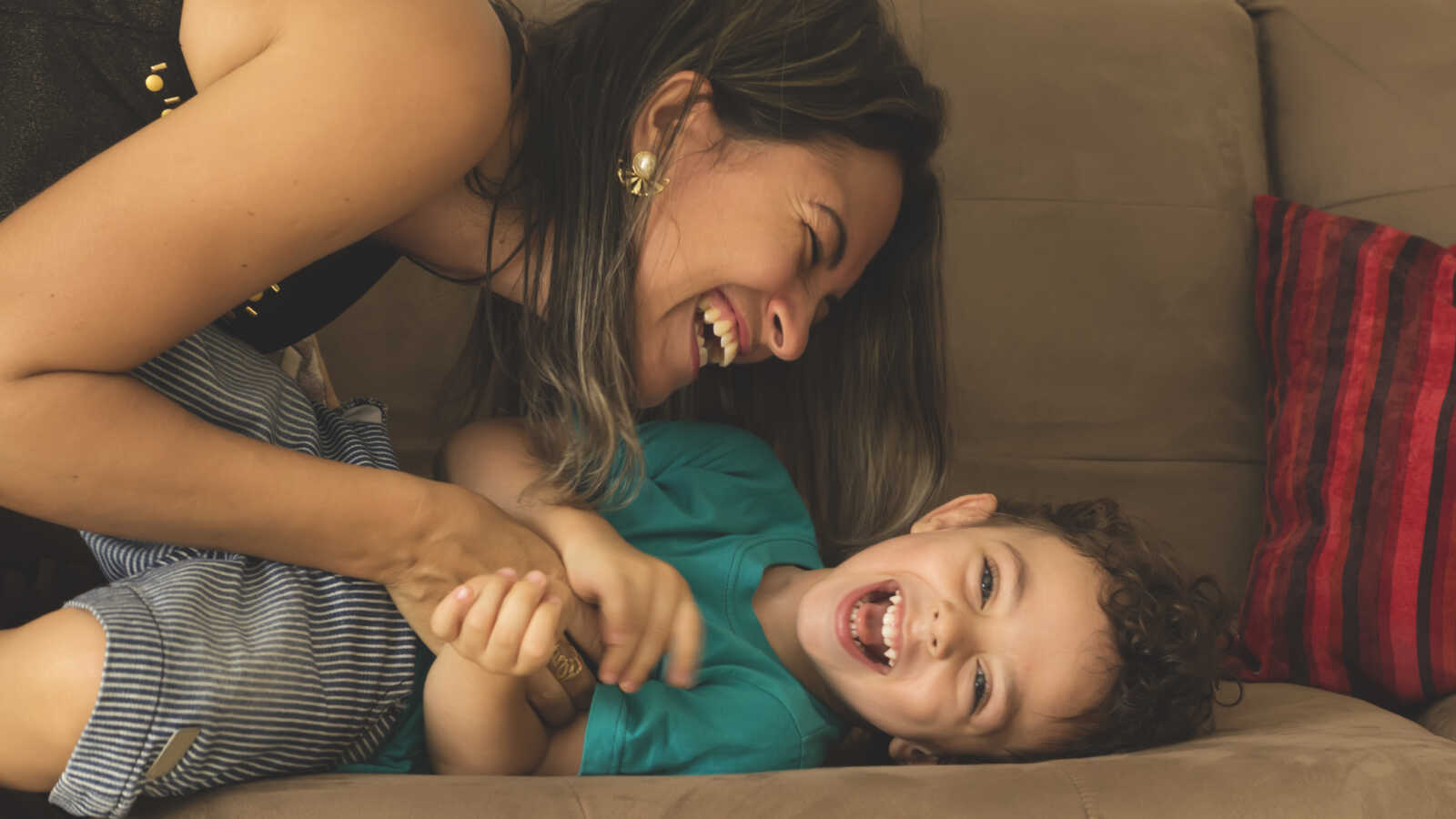We all crave those close moments with our children that melt our hearts. Connection is as essential to us as it is to our children. When our relationship is strong, it’s also sweet, so we receive as much as we give. That’s what makes parenting worth all the sacrifices.
That connection is also the only reason children willingly follow our rules. Kids who feel strongly connected to their parents want to cooperate, if they can. They’ll still act like kids, which means their emotions will sometimes overwhelm their still-growing prefrontal cortex. But when they trust us to understand and to be on their side, they’re motivated to follow our lead.
Researchers remind us we need five positive interactions to each negative interaction to keep a relationship healthy. And since we spend so much time guiding — a.k.a. correcting, reminding, scolding, criticizing, nagging, and yelling — it’s important to make sure we spend five times as much time in positive connection.
But we’re only human. There are days when all we can do is meet our children’s most basic needs. Some days it’s nothing short of heroic simply to feed them, bathe them, keep an encouraging tone, and get them to sleep at a reasonable hour, just so we can do it all over again tomorrow.
So given that parenting is the toughest job we have — and that we often do it in our spare time, after being separated all day — the only way to keep a strong bond with our children is to build in daily habits of connection. Here are 10 that don’t add time to your day, but do add connection… and could change your life.
10 Routines To Strengthen Your Parent-Child Relationship
1. Aim for 12 hugs (or physical connections) every day
As family therapist Virginia Satir famously said, “We need 4 hugs a day for survival. We need 8 hugs a day for maintenance. We need 12 hugs a day for growth.”
Snuggle your child first thing in the morning for a few minutes, and last thing at night. Hug when you say goodbye, when you’re re-united, and often in between. Tousle hair, pat backs, rub shoulders. Make eye contact and smile, which is a different kind of touch.
If your tween or teen rebuffs your advances when she first walks in the door, realize that with older kids you have to ease into the connection. Get her settled with a cool drink, and chat as you give a foot rub. (Seem like going above and beyond? It’s a foolproof way to hear what happened in her life today. You’ll find yourself glad, many times, if you prioritize that.)
2. Play
Laughter and rough-housing keep you connected with your child by stimulating endorphins and oxytocin in both of you. Making laughter a daily habit also gives your child a chance to laugh out the anxieties and upsets that otherwise make him feel disconnected — and more likely to act out.
And play helps kids want to cooperate! Which is likely to work better? “Come eat your breakfast now!” or, “Little Gorilla, it’s time for breakfast. Look, you have bugs and bananas on your oatmeal!”
3. Turn off technology when you interact
Your child will remember for the rest of her life that she was important enough to her parents that they turned off their phone to listen to her. Even turning off music in the car can be a powerful invitation to connect, because the lack of eye contact in a car takes the pressure off, so kids (and adults) are more likely to open up and share.
4. Connect before transitions
Kids have a hard time transitioning from one thing to another. If you look him in the eye, use his name, and connect with him, then get him giggling, you’ll make sure he has the inner resources to manage himself through a transition.
5. Make time for one-on-one time
Do whatever you need to do to schedule 15 minutes with each child, separately, every day. Alternate doing what your child wants and doing what you want during that time. On her days, just pour your love into her and let her direct. On your days resist the urge to structure the time with activities. Instead, try any physical activity or game that gets her laughing. (For game ideas, click here.)
6. Welcome emotion
Sure, it’s inconvenient. But your child needs to express his emotions or they’ll drive his behavior. Besides, this is an opportunity to help your child heal those upsets, which will bring you closer. So summon up your compassion, don’t let the anger trigger you, and welcome the tears and fears that always hide behind the anger.
Remember, you’re the one he trusts enough to cry with, and breathe your way through it. Just acknowledge all those feelings and offer understanding of the pain. Afterward, he’ll feel more relaxed, cooperative, and closer to you. (Yes, this is really hard. Regulating our own emotions in the face of a child’s upset is one of the hardest parts of parenting. But that doesn’t mean we’re excused from trying.)
7. Listen and empathize
Connection starts with listening. Bite your tongue if you need to, except to say, “Wow!….I see….Really?…How was that for you?…Tell me more…”
The habit of seeing things from your child’s perspective will ensure you treat her with respect and look for win/win solutions. It will help you see the reasons for behavior that would otherwise drive you crazy. And it will help you regulate your own emotions so when your buttons get pushed and you find yourself in “fight or flight,” your child doesn’t look so much like the enemy.
8. Slow down and savor the moment
You aren’t just rushing your child through the schedule so you can spend a few minutes with him before bed. Every interaction all day long is an opportunity to connect.
Slow down and share the moment: Let him smell the strawberries before you put them in the smoothie. When you’re helping him wash his hands, put yours in the running water with his, and share the cool rush of the water. Smell his hair. Listen to his laughter. Look him in the eyes and meet him heart to open heart, sharing that big love.
Connect in the magnificence of the present moment — which is really the only way we can connect. (For most parents, this is also the secret to being able to tolerate playing that same game, yet again.)
9. Bedtime snuggle and chat
Set your child’s bedtime a wee bit earlier with the assumption you’ll spend some time visiting and snuggling in the dark. Those companionable, safe moments of connection invite whatever your child is currently grappling with to the surface, whether it’s something that happened at school, the way you snapped at her this morning, or her worries about tomorrow’s field trip.
Do you have to resolve her problem right then? No. Just listen. Acknowledge feelings. Reassure your child you hear her concern, and you’ll solve it together tomorrow. The next day, be sure to follow up. You’ll be amazed how your relationship with your child deepens. And don’t give this habit up as your child gets older. Late at night is often the only time teens will open up.
10. Show up
Most of us go through life half-present. But your child has only about 900 weeks of childhood with you before he leaves your home. He’ll be gone before you know it. Try this as a practice: When you’re interacting with your child, show up 100 percent. Just be right here, right now, and let everything else go.
You won’t be able pull this off all the time. But if you make it a habit several times a day, you’ll find yourself shifting into presence more and more often, because you’ll find it creates those moments with your child that make your heart melt.

This article was submitted to Love What Matters by Dr. Laura Markham, founder of AhaParenting.com and author of Peaceful Parent, Happy Kids and Peaceful Parent, Happy Siblings. Join the Love What Matters family and subscribe to our newsletter.
Read more stories like this:
13 Habits That Raise Well-Adjusted Kids
Why I’m Raising My Kids Like It’s The 90’s
Do you know parents who could benefit from this story? Please SHARE on Facebook or Twitter to help parents strengthen these bonds with their children.



